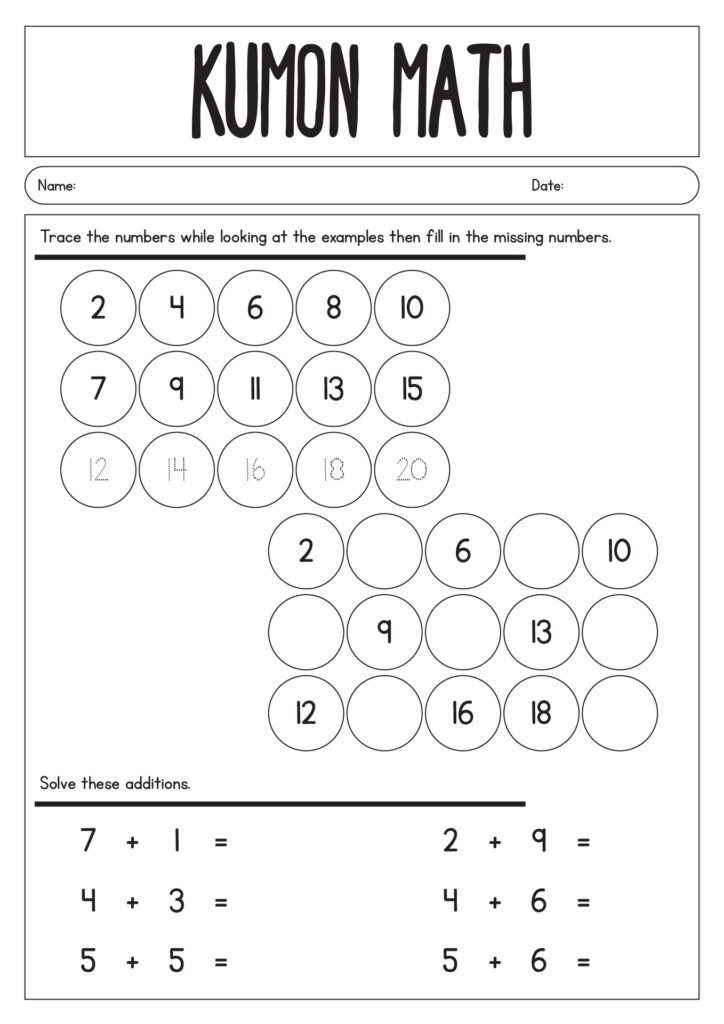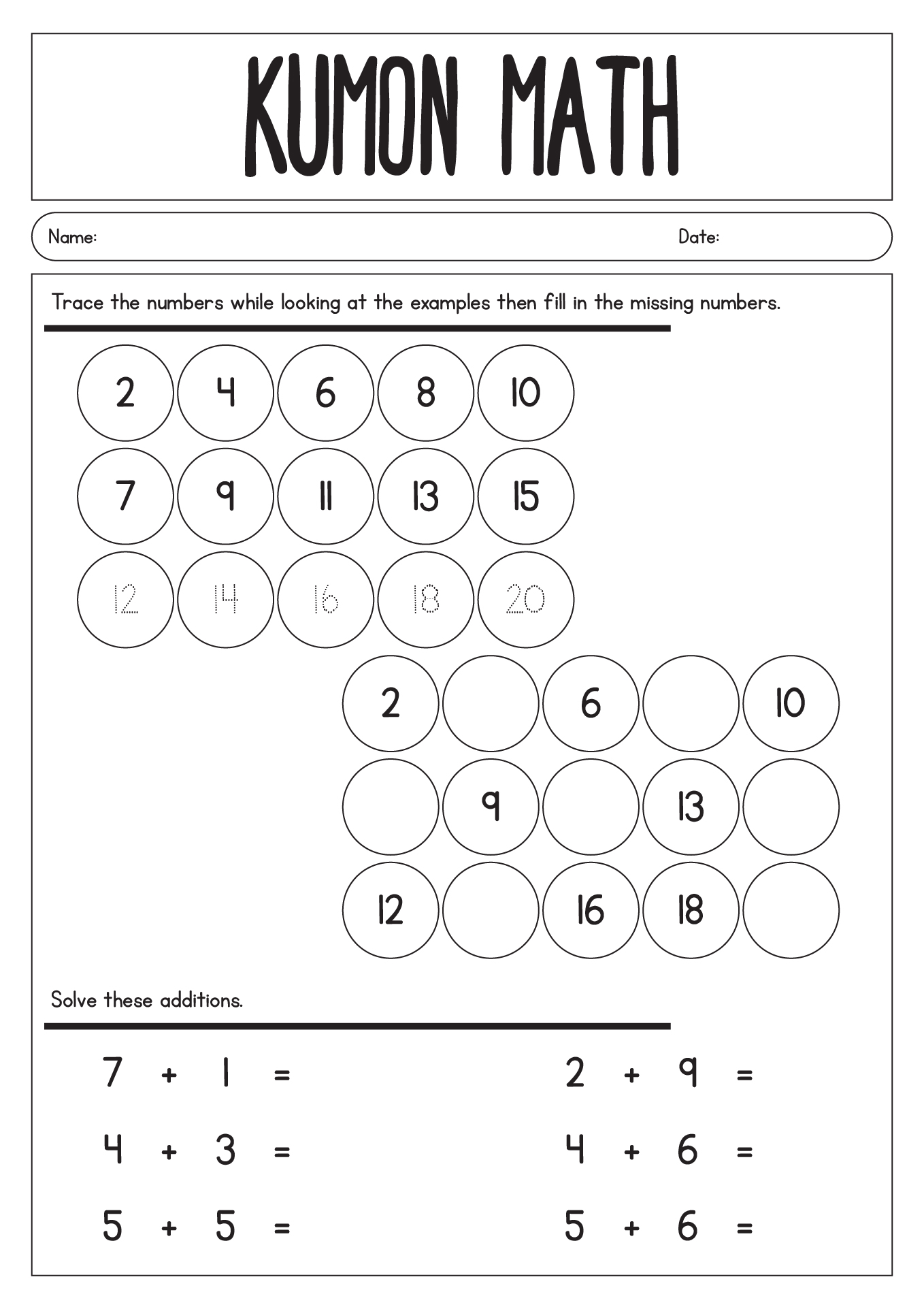Kumon worksheets have been at the heart of the Kumon Method, a globally recognized self-learning system that helps students develop strong academic skills in mathematics and reading. Originally founded by Toru Kumon in Japan, the method has gained popularity worldwide, allowing students to build essential skills through daily practice. These worksheets are designed to promote independent learning, critical thinking, and problem-solving abilities, gradually increasing in difficulty to help students advance at their own pace.

Structure and Design of Kumon Worksheets
Kumon worksheets are carefully designed to follow a structured approach that aligns with a child’s ability rather than their age or grade level. The primary aim is to develop fluency, speed, and accuracy in both math and reading, fostering a solid foundation for lifelong learning. The worksheets start with simple exercises that help students grasp fundamental concepts before progressing to more complex problems.
Each worksheet contains exercises that encourage students to work out answers on their own, with minimal guidance from instructors or parents. The problems are arranged in a logical sequence, ensuring that learners can build upon previously acquired skills without experiencing significant difficulty.
In the math program, worksheets start with number recognition and basic counting before advancing to arithmetic operations, fractions, algebra, and calculus. The reading program, on the other hand, introduces phonics, vocabulary, sentence structures, and comprehension skills that gradually progress to critical analysis of literary works. This systematic approach ensures that students are not overwhelmed while also challenging them to improve their skills incrementally.
The Self-Learning Approach
A distinctive feature of Kumon worksheets is their emphasis on self-learning. Unlike traditional classroom settings where teachers provide direct instruction, Kumon encourages students to discover solutions independently. This method helps them develop confidence and a sense of responsibility for their learning.
By following step-by-step examples and using their reasoning skills, students learn how to solve problems without immediate help. This approach nurtures perseverance, patience, and resilience, qualities that are valuable not only in academics but also in real-life situations. The self-learning model also ensures that students do not become overly dependent on teachers or parents for guidance, fostering autonomy in their education.
Gradual Progression and Mastery
Kumon worksheets are structured to ensure that students master one concept before moving on to the next. The program is divided into levels, each focusing on specific skills that build upon previous lessons. As students progress through these levels, they gain mastery over essential concepts, reinforcing their ability to tackle more challenging problems with ease.
The worksheets also emphasize repetition and practice, helping students refine their accuracy and speed. This continuous reinforcement ensures that concepts are deeply ingrained, reducing the likelihood of students forgetting key concepts over time. By mastering fundamental skills, students gain the confidence to handle more complex tasks independently.
Benefits of Using Kumon Worksheets
One of the biggest advantages of Kumon worksheets is that they provide a personalized learning experience. Unlike traditional classroom instruction that follows a fixed pace, Kumon allows students to advance at a speed that suits their abilities. This customized approach is particularly beneficial for students who may struggle with certain topics, as it provides them with the time and practice needed to fully grasp concepts.
Additionally, the worksheets are designed to improve time management skills. Since students are expected to complete worksheets daily, they develop a routine that enhances their discipline and focus. The structured nature of the worksheets also helps students enhance their problem-solving abilities, as they are required to think critically and apply logical reasoning to complete exercises correctly.
Kumon worksheets also help bridge learning gaps by identifying areas where students may need additional practice. Because students progress at their own pace, they can revisit previous levels whenever necessary to reinforce their understanding before advancing. This targeted learning approach ensures that students do not move ahead with weak foundational skills, reducing the risk of academic struggles later on.
Role of Instructors and Parents
Although Kumon worksheets promote self-learning, the role of instructors and parents is still crucial in the process. Instructors assess each student’s abilities through diagnostic tests and determine the appropriate starting level. They provide guidance on how to approach the worksheets while ensuring that students remain motivated and engaged in their learning journey.
Parents also play an essential role by encouraging consistency and commitment. Since Kumon worksheets are meant to be completed daily, parental support is necessary to ensure students maintain their practice routine. Parents can also provide additional motivation by celebrating milestones and progress, helping children stay enthusiastic about learning.
Challenges and Considerations
While Kumon worksheets offer numerous benefits, they also come with challenges. Some students may find the repetitive nature of the exercises monotonous, leading to a loss of interest over time. To counter this, instructors and parents can incorporate incentives or breaks to make learning more enjoyable.
Additionally, since the program requires daily practice, some students may struggle with maintaining consistency, especially if they have other extracurricular commitments. Parents should help establish a manageable schedule that balances Kumon practice with other activities to prevent burnout.
Another concern is that students who rely too heavily on worksheets might miss out on interactive and collaborative learning experiences. While self-learning is beneficial, it is equally important for students to engage in discussions and group activities that enhance their social and communication skills. Therefore, a well-rounded education should include both Kumon practice and interactive learning experiences.
Conclusion
Kumon worksheets have proven to be a highly effective tool for developing strong academic skills in math and reading. Their structured design, self-learning approach, and emphasis on gradual progression enable students to master fundamental concepts while building confidence and independence. By fostering a habit of daily practice and critical thinking, Kumon worksheets prepare students for academic success and beyond.
However, to maximize the benefits of Kumon, students, parents, and instructors must work together to maintain motivation and ensure a balanced approach to learning. While Kumon worksheets serve as an excellent foundation for skill development, they should be complemented with other interactive and engaging educational experiences to create a holistic learning environment.
Incorporating Kumon into a child’s educational journey can yield significant long-term benefits, shaping them into self-sufficient learners who are prepared to tackle academic and real-world challenges with confidence and competence.
